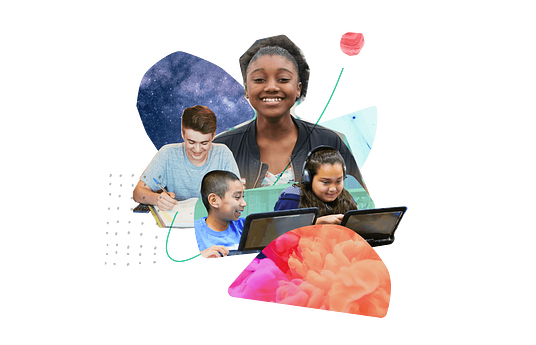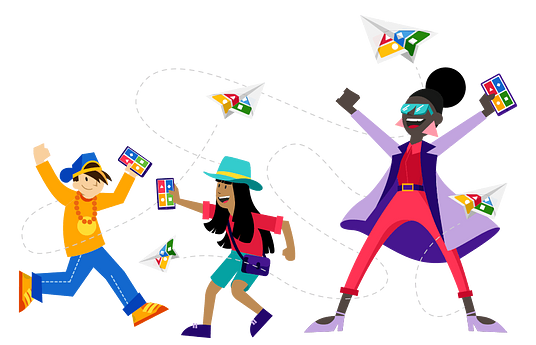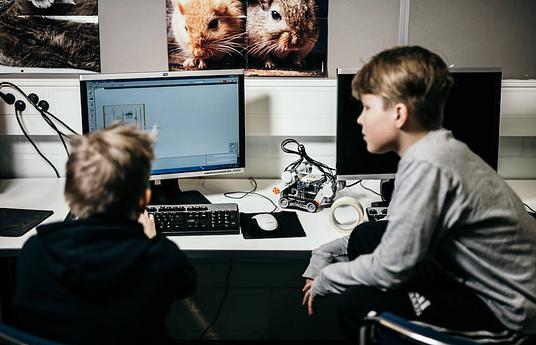As learning shifts to virtual spaces, what are the key moves teachers and leaders need to make to support students to cultivate deep learning from a distance? In this webinar, leaders of The Forest School and the Institute for Self Directed Learning shared key strategies school leaders and teachers can employ to inspire learners to shoulder the responsibility for their own learning.
Presenters Dr Tyler Thigpen, Brittney Toles, Caleb Collier, Amber Bryant, and Mary Laughlin are Guides at The Forest School in the United States. The Forest School is an independent micro-school in South Atlanta—grades K-12—that incorporates learner-driven technology, Socratic discussions, hands-on projects, and real-world apprenticeships in an intentionally diverse and character-forging community. Tyler, Brittney, Caleb, Amber, and Mary are also co-founders of the Institute for Self Directed Learning, a partnership that equips teachers and school leaders to design schools and classrooms that move students from being dependent learners to becoming self-directed, independent learners. You can find a link to the presentation they used in the video here.
Below you will find a brief summary of the 15 strategies discussed and the corresponding timestamps from the webinar.
Key beliefs (8:40-10:06)
Dr Tyler Thigpen opens the session with the admission that not all the strategies covered in the webinar will not apply in every context. He goes on to say that although this is a time of great hardship it also presents an opportunity for students today:
“This is, of course, an incredible opportunity for learners at this moment in history, in particular, children right now have more freedom to choose what they want to learn, when they want to learn, where they want to learn it, and how quickly they want to pace themselves. For some learners, in some countries and contexts while working from home children can, for the first time, practice what might be considered the future of work and remote learning.“
Negotiating Safe, High-Speed Internet Access for Every Student at Home (10:07-12:32)
Teachers or school leaders serving students in places where there is not strong internet connectivity or where learners do not have access to devices should advocate publicly to get learners access to the Internet and devices. Research suggests learning can be deeper and achievement gaps between subgroups of students can be reduced when learners have full Internet connectivity and access throughout the entire school day.
Daily Student Goal Setting (12:35-15:19)
At the Forest School students or ‘heroes’ gather every morning either in small groups or with their ‘running partners’ to set their daily tasks. This daily plan helps students to set goals. It allows them to where they are in their individual learning plan and what they need to work on.
The Use of E-Learning Platforms (15:21-16:38)
E-learning platforms help teachers establish if they need to schedule a time to “target practice” or pair that student up with another student who is very good in the target area or if they instead need a one-on-one session with their guide. These platforms also support students’ individual learning plans and help them decide what they need to focus on.
The Promise of Short, Daily Socratic Dialogue (16:40-18:12)
Classes gather every day for a 15 minute morning Zoom call. This discussion is meant to inspire students to think deeply about themselves and the world around them and how they can apply what was talked about in their daily lives. They always start with a 3-4 minute story that could be a moral dilemma or a current event.
Tips for designing Socratic Dialogues: Include a complex A/B Socratic question or complex A/B/C Socratic question with no clear right or wrong answer. Guides speak for no more than 3-4 minutes and students speak for the remaining 10-12 minutes. Try to start with an inspiring story. Do not use declarations and avoid yes or no questions. Begin with something that immediately "hooks" the audience, this experience is meant to most inspire learners every time. Suggested topics include: an inspiring hero, civilization, science, a quest, a character trait, theory or framework, an event, etc. One final tip regarding length, it’s helpful to prepare by timing your inspiring intro story ahead of the launch to make sure it's short and to the point.
Scheduling Structure and Deadlines (21:00-23:42)
After their morning Socratic Dialogue students are able to set their own schedules and goals. In the afternoon they have an hour of collaborative work time where they do project-based learning, virtually. Students co-create their schedules with teachers and choose what they want to work on and how long they want to work on it.
Incentives and Natural Consequences (23:44-25:32)
Intrinsic and extrinsic motivators are used to help keep students engaged in what they are doing. Children are given the freedom to choose their own ‘passion projects’ and guides help to celebrate learners for their progress. Students who do not complete their daily challenges face the natural consequences of their actions by having that challenge remain incomplete.
Teaching Students about Flow (25:33-27:27)
When the school first shifted to a remote environment one of their first challenges was to ask students where they are working, what they are surrounded by, how much time they are spending on tasks, are they taking breaks, how are they cleaning their heads from work? The goal of this is to find out how to maximize productivity but also take the time to take breaks and keep a healthy mindset.
Foster Companionship and Camaraderie (35:30-37:25)
Examples of things they have done to help keep learners motivated and foster camaraderie are competitions, for example, giving rewards for the highest amount of Kahn Academy minutes received and for winning Kahoot Games. In addition, they have promised pizza parties for when they go back next year, they have done dance parties and. There is also a designated break time where they can come and join one of these activities. They highlight specific students who have completed their goals. These students receive badges in the form of a physical passport that is stamped in a public ceremony.
Remote Apprenticeships (37:26-38:16)
Learners have to complete four 20 hour apprenticeship throughout the year. Some of them are now doing that virtually. They partner with someone working from home and completes various tasks. The internship can be in something they are interested in or not interested in so that when they think of their long term goals and where they want to be they have an opportunity to experience a breadth of jobs.
Regular Teacher-Student Check-ins (38:16-40:44)
Students have a 15-30 minute weekly check-in where they look at their entire badge plan to identify gaps so that learners can fill them. There are also two parent conferences a year to check in with parents.
Art and other Projects (40:00-43:15)
Art was described as creative experiments and fostering the outcome of creativity. Learners are given a challenge in the morning then they have to present their results at the end of the day to their peers. Examples of this are creating cardboard cities, and nature collages outside, creating stop motion films using the google chrome book extension and doing blind contour drawings of their studio mates over Zoom calls.
Communication and Feedback (45:10-46:45)
Communication and feedback with learners, parents, and among the team is critical during this time. Parents are sent a weekly Survey Monkey with two questions:
- On a scale from 1 to 5 how satisfied were you with your learners learning experience this week
- What could we do to improve?
Virtual Parent Coffees (46:50- 47:38)
Parents get the chance to connect and workshop how to best support their learners at home. They start with the same type of Socratic questions and allow parents to engage and help brainstorm ideas.
Slack (or similar platforms) or Mentoring or ‘Running Partners” to Aid Scale (47:39-48:42)
Mentoring, using older more experienced learners to support younger less experienced learners to increase influence and scale. ‘Running Partners’ learners have partners and they set goals every day together with their running partners.
Additional Resources:
Characteristics of Dependant and Independent Learners
ASTRA NOVA NETWORK: A free open-sourced space to share compelling projects.
Subject-specific classroom resources: Dreambox (Math), Lexia (Language), Amira (Reading), Khan Academy (Middle/High School Math), No Red Ink (Grammar), Goodreads (Writing book reviews)
The Presenters
Dr. Tyler S Thigpen is co-founder and head of The Forest School and Institute for Self Directed Learning, and Instructor at the University of Pennsylvania Graduate School of Education. Tyler has worked closely on innovative school projects such as nXu, Whittle, The Academy Group, Washington Leadership Academy, Art in Motion, Hebrew Public, Teton Science's Place Network, EL Education, and the Brooklyn STEAM Center, and has written on education leadership and innovation in the Washington Post, Education Week, Atlanta Journal-Constitution, Getting Smart, and others.
Caleb Collier is the Middle School Guide at The Forest School and cofounder of the Institute for Self Directed Learning and is currently pursuing a PhD in Teaching and Learning at Georgia State University.
Mary Laughlin is the Art Guide at The Forest School and cofounder of the Institute for Self Directed Learning. She enjoys providing creative experiences for children K-12 in the school setting, as well as at home with her three children. Additionally, she has worked in a variety of environments with children and adults in the non-profit sector, using art and creative thinking to help them discover their purpose and passions.
Brittney Toles is the High School guide and School Administrator at The Forest School and cofounder of theInstitute for Self Directed Learning. Her background is in Social Work and Education with a focus on Experiential Learning and Development.
Amber Bryant is the Elementary School guide The Forest School and cofounder of the Institute for Self Directed Learning. She has a degree in Human and Environmental Sciences. She has served the Henry and Fayette County communities as a Montessori guide and assistant in both the Upper and Lower Elementary classes.




